Sign up for our newsletter
The books
This methodology with 24 steps and 15 tactics was created at MIT to help you translate your technology or idea into innovative new products. The books were designed for first-time and repeat entrepreneurs so that they can build great ventures.

In my career as a CTO I’ve built many products; a few have been successful, while many have fallen short of expectations. However, embedding Disciplined Entrepreneurship at the heart of how I approach new proposition development has helped the businesses that I coach to test, learn and succeed more often.
The broken path of new propositions in larger businesses
My first experience with Disciplined Entrepreneurship was working in a well established organisation that already had a number of teams and business units. As the most ‘digital’ division of this large business, it wasn’t uncommon for us to inherit projects tagged with the ‘innovation’ label. We were regularly tasked with challenges like, “Do Uber, but for X”, or “Build AirBnB for Y”.
Our product and engineering teams were experienced and mature, and we took user research, product discovery and the tenets of Lean Startup seriously. However, all too often a loud voice in the executive team could propose a solution for a problem before we had really fully considered whether it was a good proposition – either for customers or commercially.
On more than one occasion a completed product that appeared to demonstrate good product/market fit remained on the metaphorical shelf, never racking up the sales we expected but leaving the business with massive bills for product development, engineering and marketing.
Disciplined Entrepreneurship in Practice
On one of these ‘Build Uber for X’ projects, we made the decision to use a new innovation process – Disciplined Entrepreneurship. We rejected the solution that had been proposed by a group of well paid C-level executives and instead worked diligently through the 24 steps of Disciplined Entrepreneurship. While much of the process would be familiar to any good product engineering organisation, we were left with a very surprising outcome.
Customers loved the concept that we were proposing and, even better, they were willing to pay for it. Both sides of a two-sided market were excited to engage and we had solid evidence that the product would even make money. Disciplined Entrepreneurship had allowed us to demonstrate, better than ever before, a huge number of learnings about our new business.
But… customers wouldn’t know that our solution existed, and without awareness we would make no sales. We predicted that our first year marketing costs would be measured in millions of pounds (or dollars) – a big gamble on a nascent market.
We were left with a decision – to build the product, incur the costs of development, sales and marketing, or wait for some well funded startup to take first mover advantage. If that happened we could pounce, using our brand and reputation to decrease our go-to-market cost, and let the first mover bear the significant cost of educating customers.
We chose to wait, avoiding a potentially massive investment in a product that we knew little about. Even today, years later, that first mover never moved.
This experience drove home just how the Disciplined Entrepreneurship approach, so well suited to the creation of new, startup businesses, could be equally as powerful in corporate innovation teams and established business units tasked with new revenue targets.
Since that first experience with the Disciplined Entrepreneurship process I have been developing a process to fit the requirements of larger, established organisations around the DE principles. A key to this is creating a culture of ‘discovery’, with the ability to put together small, multi-disciplinary teams to stand up and challenge assumptions.
A disciplined process for producing new propositions and products
Startups are uniquely positioned to fail. They are backed by venture capitalists, who make money by playing with probabilities. It’s required that venture funds make enough from their startups to ‘return the fund’, or pay back the investors of the fund with interest. Typically, only a handful of these startup bets will return 10x (or 100x) profits. Most – perhaps 60-70 out of a cohort of 100 investments in a fund – will fail, losing all of their invested cash. The venture capitalists and their investors make these precarious investments work by the size of their portfolio.
Corporates can’t tolerate – or afford – these failure rates. New propositions need a more circumspect path, and it’s here that Disciplined Entrepreneurship can uniquely help large businesses tasked with innovation, expansion or product extension targets. The target becomes not success for individual startups, but rather a profitable new proposition pipeline which kills commercial failures quickly, and as early in their development as possible.
At a certain scale and maturity, businesses will start to carve out investment funds for riskier bets. These funds are usually gated, with a senior group established to apportion the funding to product extensions, features, projects or business units.
But whether it’s a radical startup or the rollout of a new finance system, the same truth applies: at the beginning of a project, we know least about it.
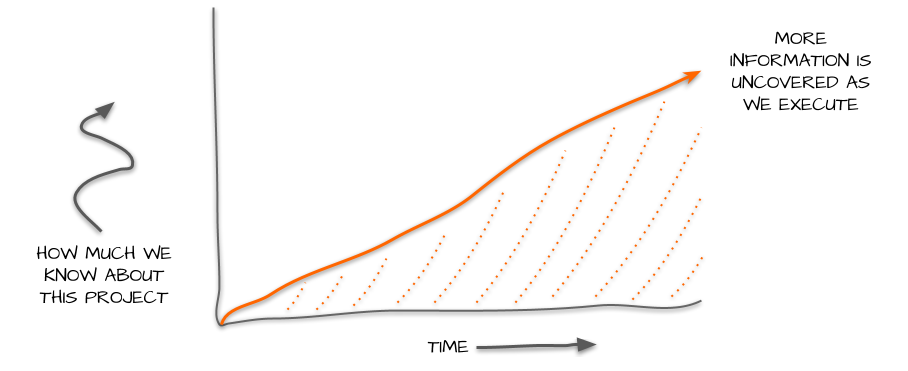 Our aim therefore becomes to drive as much learning as possible, as quickly and cheaply as possible. This allows us to drive a much more disciplined and efficient investment model, by approving smaller pieces of work, each increasing our knowledge and certainty of an outcome, with costs only increasing as we become more sure of the viability of an idea.
Our aim therefore becomes to drive as much learning as possible, as quickly and cheaply as possible. This allows us to drive a much more disciplined and efficient investment model, by approving smaller pieces of work, each increasing our knowledge and certainty of an outcome, with costs only increasing as we become more sure of the viability of an idea.
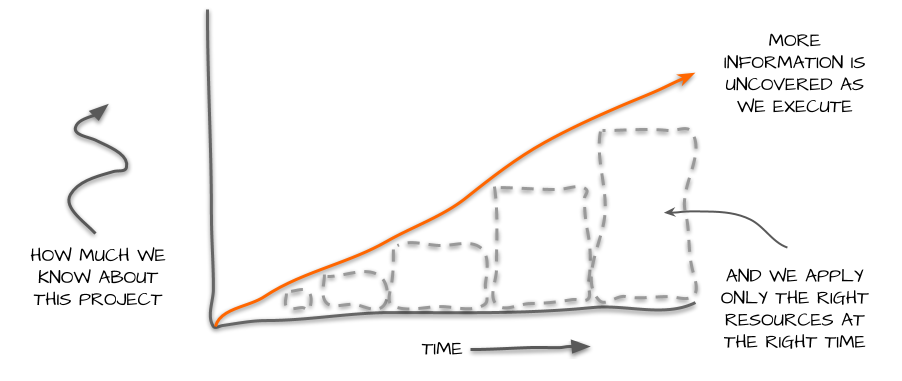 This is the ideal pattern for large companies to maximise the outcome (and profitability) of their bets.
This is the ideal pattern for large companies to maximise the outcome (and profitability) of their bets.
However, it can still be difficult for companies to break down solutions into smaller chunks and it’s here that a process for breaking down ideas into appropriate stages becomes critical.
Discovery, Definition & Delivery
In the most simple approach to gating investment, companies can adopt a three stage process, something I call ‘Discovery, Definition and Delivery’.
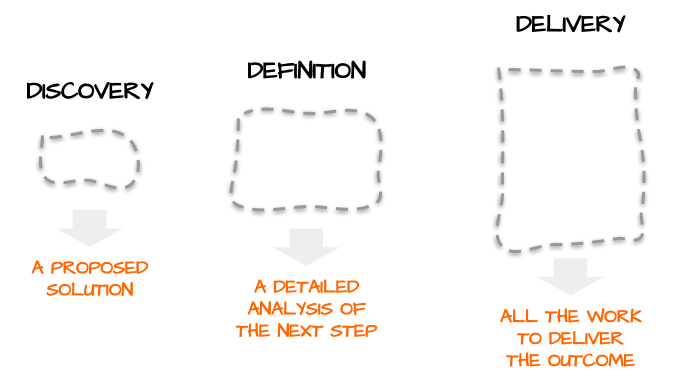 This process requires that our entry into an investment process is ‘discovery’. Discoveries begin with a statement of a challenge, a problem or an opportunity – and never a solution.
This process requires that our entry into an investment process is ‘discovery’. Discoveries begin with a statement of a challenge, a problem or an opportunity – and never a solution.
Discoveries should be small, cheap, efficient and run by the smallest possible team. This could be as simple as bringing a few people together for an hour to discuss the problem, to run some simple tests with customers or a larger activity that may span a week or two. The output of a discovery is a recommendation for whether further effort is worthwhile, the proposal of a solution, and more detail about what might be required in the next phase.
Before rushing into delivering our solution, the next phase, ‘definition’ allows a team more time to really consider how we would go about delivering the proposed solution – whether we build it ourselves, partner with another business, buy a product – or even another company. The output of definition is a clearer view of the potential upsides and the real costs. The intent behind the definition stage is to ensure that people close to the means of delivery can be involved to validate the cost and approach to the solution.
Delivery, quite simply, is the delivery of the defined solution. At its heart, this formal process is simply trying to move us from a low investment gate, through higher investment gates as we get more clear on outcomes.
A unified approach for improving our chance of success
Embedding a discovery capability within teams is critical to responsibly gate how we spend our scarce resources. Rather than a rigid process, discovery is a mindset that encourages us to creatively explore problems, and to walk away with our learnings documented.
An evolution of the three phase ‘discovery, definition, delivery’ process is a single, unified approach, which puts discovery at the heart of our investment thinking.
In this new model, there are no defined steps, but rather a contract that establishes how we validate opportunities and challenges, learn as quickly and cheaply as possible and make decisions on whether we should invest more into particular propositions.
We can replace the three stage model, with this:
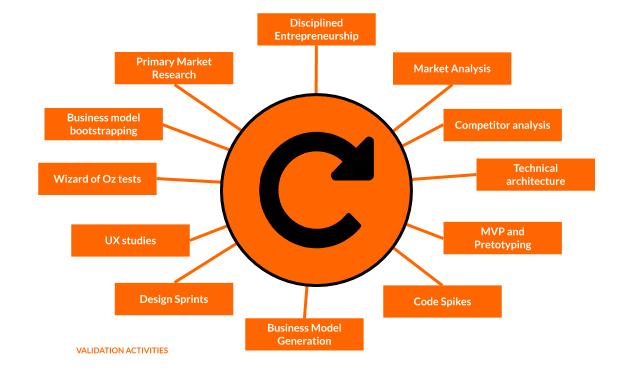 Imagine that every step of our process has some default inputs and outputs – this is the contract with our business and stakeholders.
Imagine that every step of our process has some default inputs and outputs – this is the contract with our business and stakeholders.
We start the process with a 1) challenge, 2) what resources we will require to increase our knowledge, and 3) what the outcomes might be if we succeed.
At the end of the process, we should be able to suggest 1) a new challenge (or propose to kill the project based on what we’ve learned), 2) what resources we require and 3) what we may receive as an outcome. The process feeds itself, with progression controlled by our investment gating.
But what is the magic process that the team undertake? This is as variable as the challenges we face – for some it could be customer research. For others, maybe a code spike. Perhaps some economic analysis. Maybe even a week-long Design Sprint, or creation of an MVP. The process must be flexible enough not to artificially constrain the activities, based on investment thresholds or bureaucracy.
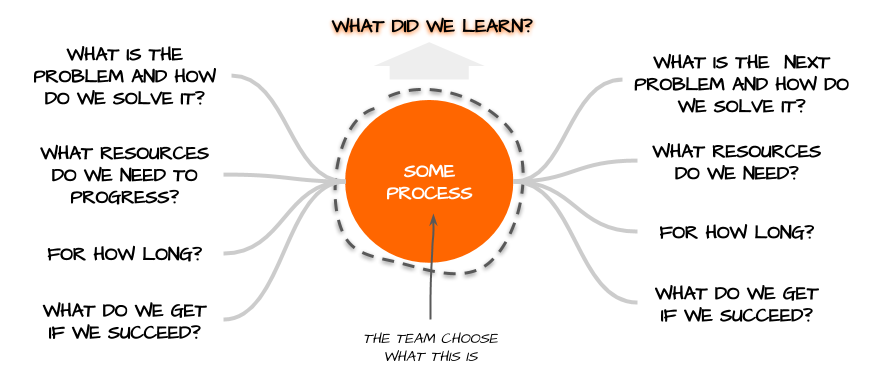 Once again, the point is that a team close to the challenge decide who the right people to work on the challenge are, how much it will cost, what the outcome might be – and crucially, what the best activity to run next is. The process continues to feed itself, from small, cheap investments to much larger ones.
Once again, the point is that a team close to the challenge decide who the right people to work on the challenge are, how much it will cost, what the outcome might be – and crucially, what the best activity to run next is. The process continues to feed itself, from small, cheap investments to much larger ones.
Merging your investment process with Disciplined Entrepreneurship
For those familiar with Disciplined Entrepreneurship, you’ll appreciate that Disciplined Entrepreneurship is a series of 24 steps, each leading logically to the next.
At any stage, a proposition may fail to demonstrate that there’s a sensible business outcome, and we may fall back to earlier stages to pick another bet. The Disciplined Entrepreneurship stages contain a number of crucial learning steps for any entrepreneur.
The unified method proposed here establishes a very clear governance structure that allows companies to adopt all of the 24 steps of Disciplined Entrepreneurship into their own innovation and new proposition pipelines. Rather than signing off entire teams to run Disciplined Entrepreneurship end-to-end, we can see how a discovery mindset will allow us to use the phases of Disciplined Entrepreneurship – or a number of other beneficial learning processes like Design Sprints – within a corporate framework for innovation and product expansion.
By introducing this governance structure and an understanding of the 24 steps of Disciplined Entrepreneurship, we can test and learn quickly, meet the requirements of financial governance but still produce well considered, innovative and commercially viable products.
Watch Mark Ridley’s presentation here:
The author
Mark Ridley
Mark Ridley is a top 10 UK CIO, entrepreneur and technologist advising executive teams, investors and startup founders on their strategy and structure.

The Disciplined Entrepreneurship Toolbox
Stay ahead by using the 24 steps together with your team, mentors, and investors.
How relevant was this article to you?
Click on a star to rate it!
Average rating 5 / 5. Vote count: 5
No votes so far! Be the first to rate this post.
We are sorry that this article was not useful for you!
Let us improve this post!
Tell us how we can improve this post?
